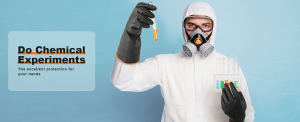
The so-called chemical protective gloves are to form an effective barrier between the hands and the chemical reagents used in the experiment to protect the hands from the harm of chemical reagents. There are various types of reagents used in chemical experiments, and the materials of gloves are also different. Is there a certain material of gloves that can protect almost all chemical reagents? How to choose gloves of suitable materials? How to judge the protective effectiveness of gloves?
The materials (or surface coatings) of chemical protective gloves are typical polymer materials, such as nitrile rubber, polyvinyl chloride, butyl rubber, polyvinyl alcohol, natural rubber, etc. The reason why these gloves can play an effective protective role is that the glove material cannot be dissolved and penetrated by the chemical reagents it contacts. On the contrary, the reagent will dissolve the gloves and penetrate through the gloves to contact the skin of the hands.
Analysis of the selection of chemical protective gloves:
1. Natural latex gloves
Natural latex comes from the milky white liquid that flows out when rubber trees are tapped, and its main component is cis-1, 4-polyisoprene. Latex gloves do not have protective properties against non-polar solvents, strong oxidizing concentrated sulfuric acid and concentrated nitric acid, and are suitable for commonly used alkali solutions, acid solutions, low-concentration sulfuric acid, salts, some alcohols, polar solvents, etc. in laboratories.
2. Nitrile gloves
Nitrile rubber is copolymerized by two monomer units, butadiene and a small amount of acrylonitrile, and has the properties of both homopolymers. Unlike latex gloves, nitrile gloves are insoluble in non-polar solvents and can effectively withstand non-polar reagents such as alkanes and cycloalkanes, such as n-pentane, n-hexane, cyclohexane, etc. Most of these reagents are marked in green. Nitrile gloves have poor or no protective properties against dimethylformamide, acetone, butanone, tetrahydrofuran, chloroform, dichloroethane, chlorobenzene, phenol, benzaldehyde, and ethyl acetate, and are all marked in red. Nitrile gloves are a type of protective gloves commonly used in laboratories.
3. PVC gloves
PVC itself is a hard plastic with a glass transition temperature of 78℃. However, after adding plasticizers, the glass transition temperature of the mixture of PVC and plasticizers is significantly reduced. For example, when 45% of plasticizers are mixed, the glass transition temperature drops to about -30℃. It is in a highly elastic state at room temperature and has a certain degree of high elasticity. The material texture becomes soft and can be used as a substitute for rubber. PVC gloves can be used not only for common acid and alkali solutions, but also for strong oxidizing concentrated sulfuric acid and concentrated nitric acid. For example, in 95%-98% concentrated sulfuric acid, the degradation level is G and the penetration time is 26 minutes. In 70% concentrated nitric acid, the degradation level is F and the penetration time is 109 minutes.
4. Butyl rubber gloves
Butyl rubber is made by copolymerization of isobutylene and a small amount of isoprene. Its biggest feature is that it has excellent air tightness and is the raw material for making black inner tubes of bicycles. Butyl rubber gloves have good protection against polar reagents, such as acetone, cyclohexanone, acetonitrile, dimethylformamide, dimethylacetamide, phenol, alcohols, etc. However, for non-polar reagents, the protection performance is poor. For example, n-hexane, n-heptane, toluene and xylene.
5. Polyvinyl alcohol gloves
Polyvinyl alcohol is a water-soluble polymer, so polyvinyl alcohol gloves (polyvinyl alcohol coating) cannot be used in water and aqueous solution systems, and are not resistant to acids and alkalis (including various concentrations of acid and alkali). There is no protection against methanol, ethanol, n-propanol, isopropanol, and isobutanol.
Summary:
No gloves made of a single material can protect against almost all chemical reagents.
Due to the diversity of polymer materials of gloves, the chemical structures of polymers are different, and the interactions with different reagents are also inconsistent. Therefore, considering the chemical structure, polarity, and material anti-degradation and anti-permeation data of polymers and reagents, the applicable conditions of gloves are also different.
Except for polyvinyl alcohol gloves, the other gloves are resistant to acids and alkalis and are suitable for aqueous solutions. For non-polar reagents, latex gloves and butyl rubber gloves have poor protection or are not recommended, while nitrile gloves have particularly good oil resistance. For polar reagents, latex gloves and butyl rubber gloves have good protection. Polyvinyl alcohol gloves have good protection against halogenated hydrocarbons, while nitrile gloves have poor protection against halogenated hydrocarbons.
It is recommended that each chemical experimental teaching laboratory be equipped with different types of chemical protective gloves according to the nature of the experimental course and the actual teaching situation. For example, in an inorganic chemistry laboratory, polyvinyl chloride gloves are equipped, but butyl rubber gloves are recommended for protection against concentrated sulfuric acid. In an organic chemistry laboratory, the above-mentioned commonly used chemical protective gloves are equipped, and the correct selection is made according to the use occasion and the specific product performance index test data.
Post time: Mar-27-2025